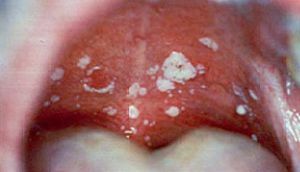 Catarrhal stomatitis is a disease that is accompanied by a course of the inflammatory process on the oral mucosa, with ulcers, wounds and other injuries on it absent.
Catarrhal stomatitis is a disease that is accompanied by a course of the inflammatory process on the oral mucosa, with ulcers, wounds and other injuries on it absent.
The disease creates discomfort to the patient, which is associated with pain syndrome and difficulty in chewing food. The methods of therapy directly depend on the cause, which provoked the development of stomatitis.
Contents
- General description
- Features
- Clinical features
- Diagnosis and treatment
- Features of the disease course in children
General characteristic of
A characteristic feature of this pathology is the absence of a variety of mucosal structure disorders, such as for aphthous form. The catarrhal form is considered the most common of all types of stomatitis. It is equally found in men and women of any age.
Depending on the nature of the symptoms, the disease can occur in two forms:
- acute;
- is chronic.
Acute catarrhal stomatitis is characterized by a vivid clinical picture, the main sign of this type of disease is the absence of symptoms indicative of the inflammatory process in the oral cavity.
The first signs of a violation are detected only when consuming acute and acidic foods. In children, the symptoms are more intense than in adults.
Timely access to a doctor, as well as compliance with all the measures prescribed by the dentist, can cure the acute form of the disease within two days.
Otherwise, the pathology gradually acquires a chronic form. In this case, the nature of the symptoms is modified. In particular, ulcers form on the surface of the mucosa. The intensity of the course of the disease increases with the weakening of immune defense and other provoking factors, among which: 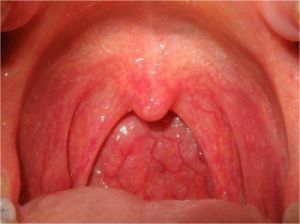
- allergic reaction;
- hormonal imbalance;
- diseases of internal organs;
- strong stress and more.
Treatment of the chronic form of catarrhal stomatitis takes quite a long time.
Provoking factors
Professionals distinguish two main causes of catarrhal stomatitis:
- non-compliance with hygiene rules;
- mucosal trauma.
The latter circumstance is the main factor provoking the emergence of pathology. To traumatization of the oral mucosa lead:
- carious processes;
- presence of cracks on the enamel and chips on the teeth;
- application of a toothbrush with a stiff bristle;
- installation of orthopedic and other dental structures;
- improper installation of seals, or from poor-quality material.
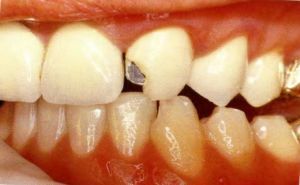
Enamel cleavage can damage the oral mucosa
Non-compliance with hygiene rules creates a favorable microflora in the oral cavity for the reproduction of pathogenic microorganisms.
Bacteria penetrate the mucosa through small cracks and provoke the formation of foci of inflammation.
Minor damage to the oral cavity is also caused by the following factors:
- deficiency of vitamins;
- iron deficiency anemia;
- inadequate production of saliva;
- smoking;
- dehydration of the body;
- helminthiases;
- pathology of the gastrointestinal tract, endocrine and cardiovascular systems;
- desiccation of the mucous membrane under the influence of chemicals.
Clinic features
The clinical picture, characteristic of the catarrhal form of stomatitis, manifests itself in the form of the following symptoms:
- redness( congestion) of the mucous membrane in the mouth;
- appearance of edema in the affected area;
- pain syndrome.
As the disease develops, the patients are noted:
- is a characteristic plaque on the mucous membrane of white or yellow;
- active salivation;
- unpleasant odor.
Because of edema, the gingival margin is often injured, which leads to bleeding. Painful sensations arise during a conversation and when chewing food. As noted above, with catarrhal stomatitis on the mucous membrane does not occur papules, erosion and other neoplasms.
In neglected cases, when pathology acquires a chronic nature of the course, inflammation foci penetrate deep tissues, provoking the formation of ulcers. Serious plaque appears on the surface of the gums with this form of the disease. In passing, the patient has a rise in body temperature and an increase in lymph nodes.
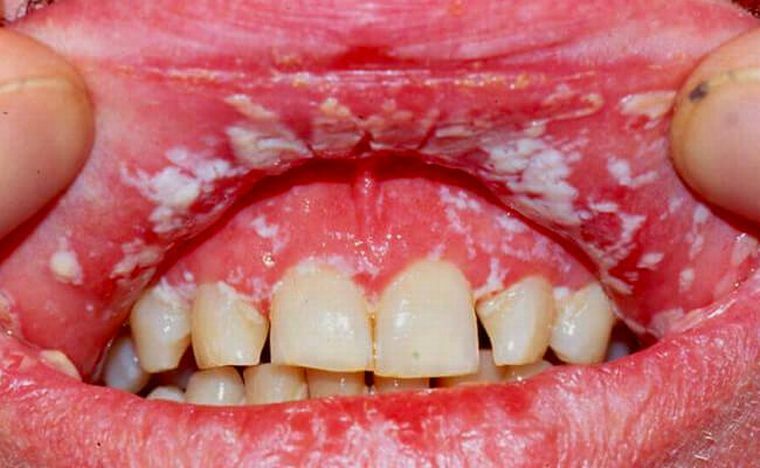
In the photo, a typical clinical picture for catarrhal stomatitis is plaque and inflammation on the mucous membranes in the mouth.
. Diagnosis and treatment of
. If suspected of catarrhal stomatitis, an external examination of the affected area is performed to detect redness and inflammation. Also, the doctor collects information about the presence of concomitant diseases that can provoke the formation of inflammatory foci. Additionally, a microscopic examination of a smear taken from the mucosa is prescribed.
Treatment of catarrhal stomatitis is aimed at suppressing the general symptoms and removing the effect of the cause that caused the development of pathology.
For this purpose, the following are assigned:
- Antiseptic processing .For these purposes, water solutions of hydrogen peroxide, chlorhexidine and other agents are prescribed.

- Solution of lidocaine or benzocaine .They eliminate the pain syndrome.
- Also for the treatment of the oral cavity, is applied from chamomile .They treat the affected area every 2-3 hours. To eliminate mucosal edema, a 5% solution of potassium chloride is prescribed. The agent takes inwards.
Depending on the cause that caused the development of the inflammatory process, the following can additionally be prescribed:
- Antibacterial agents .These include Tantum Verde( non-steroidal anti-inflammatory drug) and Hexoral.
- Antifungal medications , if it is determined that the disease is caused by a fungal infection of the mucosa. Eliminate the symptoms of pathology by regular use of the antibiotic Nystatin.
Accelerate the recovery process allows a special diet. It provides for the refusal of hot and cold foods, spicy and sour food.
Features of the course of the disease in children
Catarrhal stomatitis in children often develops in the period from 0 to 3 years. The disease develops against the background of eruption of milk teeth, which in the course of growth damage the integrity of the mucous membrane. In children, the ailment is mainly caused by infection with fungi from the genus Candida. After infection, a white coating appears in the oral cavity( thrush).
In addition to these symptoms, children can also have:
- rashes appearing on different parts of the skin;
- muscle pain;
- indigestion.
Among the main reasons contributing to the development of the disease in childhood, allocate infectious diseases. Among the latter include ENT pathologies, measles and others.
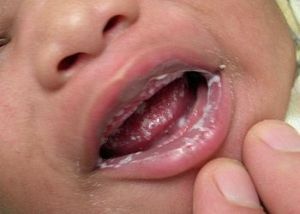 The approach to treating the disease in children is practically the same as the treatment that is prescribed for adult patients. Only dosage of medicines and type of medicines change. For example, instead of tablets prescribe a spray with a similar composition.
The approach to treating the disease in children is practically the same as the treatment that is prescribed for adult patients. Only dosage of medicines and type of medicines change. For example, instead of tablets prescribe a spray with a similar composition.
The prognosis for catarrhal stomatitis is favorable in case of timely application for help and compliance with medical prescriptions. The launched forms of pathology are accompanied by necrotic destruction of the affected tissues.
Prevention includes oral hygiene and the timely elimination of dental diseases.
